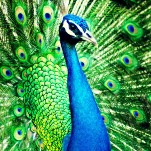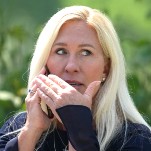Eyeliner and Liner Notes: The 1940s
In DepthWelcome back to our series on the history of makeup.
If I had to summarize the 1940s in one sentence, it would be this: Natural beauty and RED LIPSTICK, RED LIPSTICK EVERYWHERE AHHH! (Look, I never said it would be a good sentence). Since I’m here to actually explain why red lipstick and natural beauty was the overarching trend during this era, let me write many, many more sentences about it.
The 1940s – looks-wise – were relatively similar to the 1930s, with the main holdover being that lips were still the focus of the face versus highlighting eyes (which is a staple of the 1960s) or cheeks (1980s, what with all the TAKE THIS HOT PINK BLUSH NOW SMEAR IT IN A LINE DOWN YOUR FACE going on), with the main difference being that now brows were looking a whole lot more normal and lips were now being slightly over-drawn around the whole mouth, not just the upper lip. The basic 1940s look can be summarized easily: Simple, yet glamorous.
The cosmetics industry was a veritable powerhouse by the 1940s, with more brands and options than ever on the market. Several major brands – including Estée Lauder (1946), Wella (1946), and Parfums Christian Dior of Paris (1947) – were founded during the forties, with brands such as Max Factor, Coty, Tangee, Revlon, and L’Oreal picking up more of a global presence. Coty and Tangee, two brands that have definitely dropped in popularity since the 40s, were particularly big at the time. Even during the war years, brands continued to build and expand, even if their European factories were being reduced to rubble. When some of them had to halt production during the worst of WWII, they still continued to advertise out of the fear that women would forget about them if their products weren’t still front and center (because we all know how if you don’t wear lipstick for a bit you just forget that it exists. I don’t wear foundation because I don’t see a need for it, it never existed in the first place OoooOOOOOooooOOOOOoooOOO).
Obviously (unless you’ve just never studied history or read a book or watched TV and were born about 30 seconds ago with the ability to read and immediate access to the internet), one of the biggest things that affected makeup and fashion in the Western world (and, really, everywhere else, but for the sake of this article we will just be focusing on the USA and Western Europe) was World War II. With women entering the workforce in larger numbers than ever before and war rationing changing what people could get their hands on, WWII directly and indirectly affected the trends of the 1940s.
-

-

-

-

-

-

-

-

-

-

-

-

-

-

-

-

-

-

-

-

-

-

-

-

-

-

-

-

-

-

-

-

-

-

-

-

-

-

-

-








































